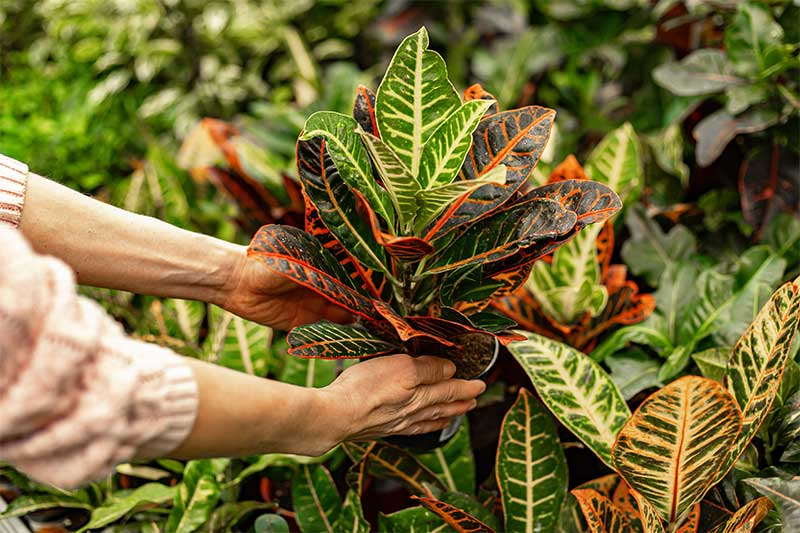In the realm of indoor gardening, the Croton Petra stands as a magnificent centerpiece, its leaves a vibrant tapestry of yellow, green, orange, and red. Known scientifically as Codiaeum variegatum, this tropical marvel brings an unparalleled burst of color to any indoor space, embodying the essence of a tropical garden.
A Deep Dive into Croton Petra's Colorful Domain
Among the myriad of croton plant varieties, the Croton Petra is particularly esteemed for its mesmerizing foliage. This dynamic array of colors isn't just for show; it signals the plant's health and its response to environmental care. The secret to its vivid display lies in the balance of chlorophyll, carotenoids, and anthocyanins within the leaves, each pigment playing a crucial role in the plant's vitality and coloration.
Lighting: The Key to Unlocking Vibrant Hues
Light exposure is paramount for Croton Petra plants to flaunt their colorful leaves. These tropical beauties crave bright, indirect light to stimulate pigment production, enhancing their vibrant hues. However, the delicate dance with sunlight doesn't end there; too much direct exposure can harm the plant, leading to falling leaves and faded colors. Here, LED grow lights can be a game-changer, offering the perfect spectrum of bright light to keep your Croton Petra in its full glory, especially in spaces where natural sunlight is a luxury.
The Perfect Growing Conditions
The Croton Petra, a striking addition to any indoor garden, thrives under specific conditions that mimic its native tropical habitat. Achieving the perfect balance of warm temperatures and bright, indirect sunlight is crucial for the Croton Petra to reach its full potential, boasting both height and a kaleidoscope of colorful foliage. Let's delve deeper into how to create the ideal environment for this vibrant plant and safeguard it from common threats like spider mites.
Temperature and Light: Pillars of Croton Petra Care
For the Croton Petra to truly thrive, it's essential to recreate the warm and humid conditions of its tropical origin. Maintaining ambient temperatures within the range of 60-85°F (15-29°C) is optimal. This warmth is crucial for the plant's well-being, as sudden temperature drops or exposure to cold drafts can stress the plant, potentially leading to the loss of its vibrant leaves or a noticeable dulling of its rich colors.
Bright, indirect sunlight is another cornerstone of Croton Petra care. This plant's signature colorful leaves owe their stunning hues to just the right light conditions. In regions where natural light is scarce, especially during the winter months, LED grow lights can be invaluable. These lights can simulate the sun's spectrum, providing your Croton Petra with the energy it needs to maintain its colorful leaves and robust growth.
Moreover, it's important to be mindful of the plant's hydration needs. The soil should be kept moist but not waterlogged to avoid root rot. Implementing a regular watering schedule, while adjusting for changes in humidity and temperature, can help maintain the ideal moisture level.
Vigilance Against Pests: The Spider Mite Threat
Spider mites, tiny arachnids that thrive in dry, warm conditions, pose a significant threat to the health of Croton Petra plants. These pests can quickly colonize the underside of leaves, sucking sap and causing damage that manifests as yellowing leaves, webbing, and potentially the death of the plant if left unchecked.
Regular inspections are a cornerstone of proactive pest management. Pay close attention to the undersides of leaves and the junctions where leaves meet stems, as these are common hiding spots for spider mites and other pests. Using a magnifying glass can help in spotting these tiny invaders early on.
Maintaining clean foliage is another effective strategy in preventing pest infestations. Wiping the leaves with a damp cloth not only removes dust that can hinder photosynthesis but also dislodges any pests taking residence on the plant. In more severe cases, a mild insecticidal soap or neem oil solution can be applied to the foliage to combat spider mites, following the product's instructions carefully to avoid harming the plant.
In addition to these measures, maintaining a level of humidity around the Croton Petra can deter spider mites, which prefer dry conditions. A pebble tray filled with water placed under the plant's pot, or regular misting, can help increase the surrounding humidity, creating a less hospitable environment for these pests.
In conclusion, the Croton Petra's vibrant display is a testament to the care and conditions provided by the indoor gardener. By ensuring warm temperatures, bright indirect sunlight, and staying vigilant against pests like spider mites, you can cultivate a healthy, thriving Croton Petra that brings a burst of tropical color to your indoor garden. Regular care, combined with preventative pest control measures, will ensure that your Croton Petra remains a stunning and resilient feature in your collection of indoor plants.
Embracing the Croton Petra in Your Home
The Croton Petra is more than just an indoor plant; it's a living sculpture that brings a tropical flair to your space. With the right care—mindful watering, adequate light, and controlled humidity—this tropical plant can transform any room into a vibrant oasis.
In summary, the Croton Petra is a testament to the beauty and diversity of indoor plants, offering a slice of the tropics with its colorful foliage. By adhering to the water and light guidelines, and ensuring the soil remains moist, you can cultivate a thriving Croton Petra that will be the jewel of your indoor garden. Whether you're a seasoned green thumb or new to the plant world, the Croton Petra is a rewarding addition to any indoor plant collection, promising a burst of color and life in every leaf.







